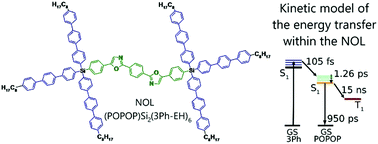Ultrafast intramolecular energy transfer in a nanostructured organosilicon luminophore based on p-terphenyl and 1,4-bis(5-phenyloxazol-2-yl)benzene†
Abstract
We report on the first experimental and theoretical investigations of ultrafast intramolecular energy transfer for a novel class of highly luminescent materials – nanostructured organosilicon luminophores (NOLs). For this purpose we designed, synthesized and investigated a NOL, (POPOP)Si2(3Ph-EH)6, consisting of six p-terphenyl (3Ph) donor and 1,4-bis(5-phenyloxazol-2-yl)benzene (POPOP) acceptor luminophores – well-known laser dyes widely used in plastic scintillators as an activator and a spectral shifter, respectively. The NOL shows excellent optical properties – molar absorption coefficient up to 2.6 × 105 L mol−1 cm−1, photoluminescence quantum yield up to 96% and pseudo Stokes shift of 100 nm. Its intramolecular energy transfer efficiency determined from steady-state optical measurements was found to be 93%, while the excitation lifetime was less than 1 ns. For deeper understanding of the processes of intramolecular energy transfer within NOLs, ultrafast spectroscopy investigations of the NOL, model donor and acceptor luminophores were performed for the first time for this class of compounds. It was found that the time constant of the energy transfer from donor to acceptor luminophores within the NOL is τ1 = 105 fs, which is significantly faster than the vibrational relaxation within the donor (ca. 400 fs). Based on these findings, a kinetic scheme of the electronic excitation energy deactivation processes in the NOL was developed. The results obtained not only directly prove that the mechanism of energy transfer within the NOLs is based on Förster resonance energy transfer of the excitation energy from donor to acceptor luminophores, but also highlight the advantages of NOLs and NOL-based materials for future photonics applications – fast and efficient plastic scintillators, scintillating fibers and other spectral shifting optical materials.



 Please wait while we load your content...
Please wait while we load your content...